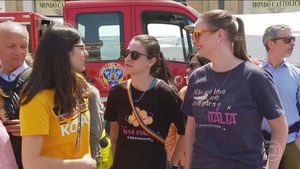Elon Musk’s Tesla Roadster has recently found itself at the center of attention, but not for the reasons one might expect. The iconic vehicle was mistakenly identified as a new near-Earth asteroid, dubbed 2018 CN41, leading to both amusement and concern within the astronomical community. This unexpected twist unfolded on January 2, 2024, when an amateur astronomer from Turkey spotted the object using publicly available data, prompting the International Astronomical Union’s Minor Planet Center (MPC) to catalog it as a newfound asteroid.
Just hours later, the excitement dissipated as the MPC retracted the classification, clarifying: the so-called asteroid was none other than Musk's cherry-red Tesla, flung deep space during SpaceX's historic Falcon Heavy launch back in 2018. The incident not only left astronomers chuckling but also highlighted the increasing issue of space debris, raising questions about the challenges of distinguishing human-made objects from genuine cosmic materials.
Originally launched with the quirky payload of “Starman,” a mannequin dressed up in SpaceX gear and supposedly listening to David Bowie’s "Space Oddity,” the Tesla has become less recognizable over the years. Now, it orbits the sun at speeds reaching 45,000 mph, completing approximately 4.5 orbits since its launch. Where the Roadster was intended for a stable orbit around Mars, it instead transformed from innovation’s symbol to another piece of space junk careening through the cosmos.
This mix-up is hardly the first of its kind. Over time, various spacecraft and space debris have been misidentified as asteroids, leading to notable mismatches. Instances include NASA’s Lucy spacecraft and the European Space Agency’s Rosetta probe, which were both erroneously recorded on astronomical watchlists. With exploration efforts booming and the number of objects launched skyward increasing exponentially, similar misidentifications are expected to become more common.
While this amusing error had no immediate consequences, experts are raising alarms over the potential ramifications of such blunders. Jonathan McDowell, a Harvard-Smithsonian astronomer, cautioned, "The worst-case scenario would be spending billions of dollars to launch... only to discover upon arrival... it’s actually just a discarded piece of space junk." The stakes are genuinely high, with inaccurate tracking of human-made debris possibly leading to:
- False alarms concerning asteroid impacts.
- Wasted research efforts on objects, leading scientists down the wrong paths.
- Collisions with operational spacecraft, introducing serious risks to missions and technologies currently active.
With over 30,000 pieces of debris presently estimated to be orbiting Earth, the situation remains precarious. This number continues to rise, creating increasing complexity for astronomers working to conduct clear observations of the universe. Many experts advocate for more stringent verification systems to handle unusual findings, recognizing the need to double-check before labeling something as significant as asteroids.
Despite its current state, the Tesla remains emblematic of SpaceX's groundbreaking achievements and the innate human tendency to push boundaries, turning curiosity to folly. Both amusing and alarming, the incident acts as a reminder of humanity's impact on the space surrounding our planet. Future interactions with these objects must be approached with caution, as scientists and astronomers contemplate the long-term effects of space litter.
The Tesla’s fate is uncertain; for now, it will keep looping around the sun for millions of years, passing near Earth and Mars time and again. But the mix-up serves as both comic relief and serious cautionary tale for the future of space exploration as calculations and policies on space debris management evolve.
Moving forward, significant measures are being initiated to proactively manage such debris. These include guidelines established through international treaties, the development of technology for active debris removal, and enhanced tracking systems to monitor existing objects. The next decade will be integral for assessing these challenges, requiring combined global efforts to mitigate the consequences of our making.
The follies of the recent confusion about the Tesla Roadster prompt reflections on our responsibility to safeguard the celestial territories we explore, ensuring our innovations do not become the caretakers of cosmic clutter.



